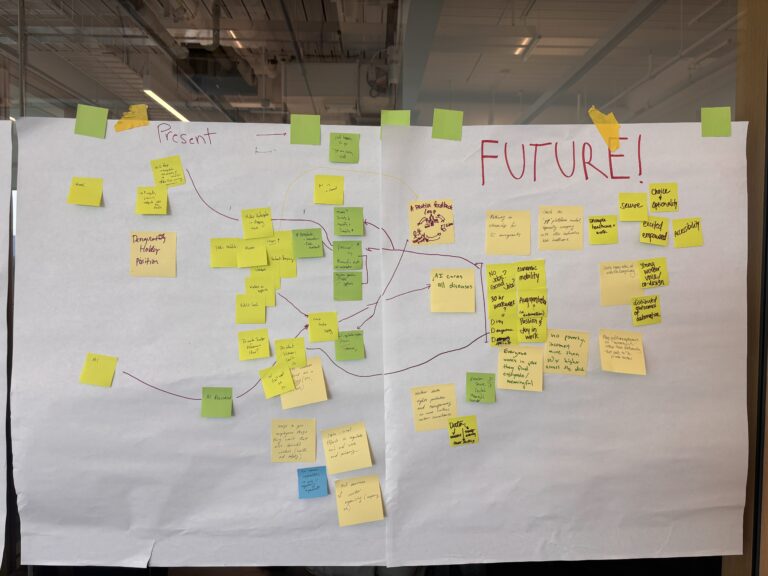by John Irons
I’m very pleased to have joined Siegel Family Endowment (SFE) as a Senior Vice President and Head of Research. A quick introduction for those that don’t already know me: I’ve long straddled the worlds of research and philanthropy, and have over 15 years experience building and leading highly analytic and creative teams tackling some of the toughest and most complex global challenges on economic systems, work, technology, financial markets, and public policy. I’ve worked in research roles within academia and in a few DC-based think-tanks. I’ve also held senior leadership roles at two major US-based private foundations. You’re welcome to view my LinkedIn profile for more details.
Since its founding, SFE has focused on understanding and shaping the impact of technology on society; and, today, SFE supports a variety of grantees in the areas of learning, workforce, and infrastructure. From its founding, SFE has supported research in these areas while also helping further programmatic work that helps students of all ages, workers, and communities.
In 2021, we are building out additional research capabilities, both in partnership with other research organizations as well as internally to SFE. This research capacity (and my role) is entirely new for the organization, and a major first, considering SFE has never before housed a research function. So why start developing an in-house research program? What is the precedent for doing research at a foundation? What does this sort of function set an organization like Siegel Family Endowment up to achieve? How will we do the work? Read on!
Philanthropy and Research
Throughout the history of US foundations, dating back to the early 20th century, expanding knowledge through research has been a focus of some of the largest and oldest philanthropic organizations. Many private foundations, such as The Rockefeller Foundation, the Ford Foundation, the Russell Sage Foundation, and the Alfred P Sloan Foundation, pioneered grantmaking for research in the last century. At some times they even organized themselves in much the same way as a research university with discipline specific “divisions.”
Over time, many research-focused funders either moved away from primarily or exclusively funding research or shifted their priorities to other activities (though not all have done so – Russell Sage and Sloan still predominantly fund research projects). For those that have changed, some shifted their strategic focus leading to new priorities; while others recognized that science and knowledge on its own was not sufficient to realize the change they sought — social, cultural, and political forces grew in importance. The relative need and impact of their resources was also diminished as research expenses grew and as there were increases in other funding sources for research. In the mid-20th century, public resources grew through government agencies like the NSF and NIH; and, more recently, resources spent by the private sector on research endeavors has increased. However, even those that shifted resources still retained some funding for research priorities that supported their programmatic goals.
Despite these shifts, funding knowledge creation remains a central focus throughout philanthropy. Today the older foundations are joined by relative newcomers such as the Gates Foundation and Robert Wood Johnson Foundation, and many others who are devoting significant resources towards research of various kinds.
How is research supported by philanthropy?
Most people today think of philanthropic organizations primarily as grantmakers, funding research and other programs on topics related to the foundation’s mission or strategy. Grant funds often go to university- or “think-tank”-based researchers and to their laboratories or research centers to pay for salaries, equipment, data collection, and other major operational expenses. This support can be for general research aligning with the joint interests of the funder and researcher, or more project based – say, to commission a particular research report on a specific subject. In this model, the funder is financially supporting the research, but largely hands off in the conduct.
However, throughout the history of philanthropy, there are also many cases where foundations have played a much more active role in knowledge creation. For over 100 years, the Russell Sage Foundation has undertaken original research using their resources both to fund research, but also to hire social scientists to conduct research, publish books and journals, and provide a home to scholars. In its early years, the Rockefeller Foundation not only funded research efforts in both social, natural, and medical sciences, but also directly operated research laboratories across the globe, including in New York City, where a vaccine for yellow fever was developed in the 1930s.
Today, there are a range of hybrid organizations (and efforts within organizations) that combine a mix of external grants and in house research or operational capacity. For example, the Economic Security Project funds some research in it’s interest areas through grantmaking, but also deploys internal capacities in support of direct impact projects, including a pilot of an Universal Basic Income program in Stockton, California. While not private foundations, The Washington Center for Equitable Growth (an SFE grantee) and MIT’s J-PAL are both organizations that produce social science research, but their core operating models include re-granting funds to support academic based researchers.
What is SFE’s perspective on research?
At SFE, we believe that to be most effective, our organization will need to maintain and grow our research efforts. This means — as others have recognized before us — not only supporting research scholars in academia and elsewhere, but also by expanding our own internal research capacity.
Like others, in its relatively short history, SFE has funded a range of research at both academic and nonprofit institutions. As examples, we’ve supported research on the future of the labor market at the Work of the Future project at MIT, and funded research on the impact of technology at Data & Society. Our goals have been to promote new and interesting projects in our focus areas. And we will continue to support external research at universities and think-tanks.
SFE’s interest in expanding our own internal research capacity is grounded in the belief that the impact potential of a philanthropic organization goes beyond the individual impact of specific grants or even broader strategies: a well-functioning philanthropy is also a learning organization. It should learn from successes as well as failures; it should connect the dots between issue silos and sectors; and it should be humble about what it knows, identifying gaps in knowledge that need to be filled. If an organization is doing this well, it should not keep those learnings secret; rather, it should share that knowledge with relevant stakeholders, and use its findings to increase its impact.
It’s our belief that we can be more effective in our endeavors and also enhance the support we provide to our grantees by creating a research function within the Endowment. This will allow us to be more than just passive learners.
In my years at two of the oldest and well recognized private foundations (The Rockefeller Foundation and the Ford Foundation) I saw the potential role for philanthropy in connecting the dots across programs, across grantees, across sectors, and across disciplines. And in my years conducting and directing research at DC-based think-tanks and in academia, I’ve seen how the power of ideas can drive change. I hope to bring some of that expertise in both realms to my time here at SFE.

John Irons is Senior Vice President and Head of Research at Siegel Family Endowment





